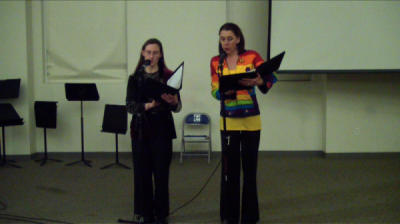Kathryn Denney and Lisa Hadley perform Anita Kupriss’s Soul Tea at Capital Community College, where this year’s Electro-acoustic Concert was held on March 8, 2012. Written for vocalists and a fixed electronics track, the piece features sound samples of a tea kettle. The composer writes:
“In the mornings I often sing along with my whistling tea kettle (doesn’t everyone?) and decided that I just had to write a piece for two (or three) female voices with a pre-recorded tea kettle background track. The pitch of the tea kettle, which undulates between an A and a Bb, sounds the pedal tone for the entire piece, while the click of the electronic starter generates a recurring rhythmic motive. The text, a series of vowels, gives the singers the freedom to create bursts of canonic melodies and modal harmonies. The singers employ glides and onomatopoeic sounds (tsik) as effects and sing descending and ascending quarter steps with the tea kettle, in order to heighten the harmonic tension. At first I thought that this would be a humorous piece, but as I composed it the mood became more melancholy which ultimately inspired me to name this song Soul Tea.”






